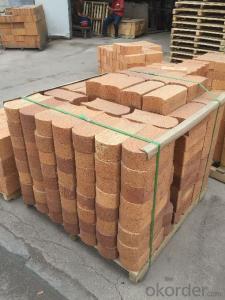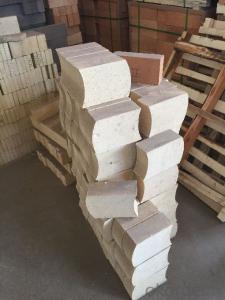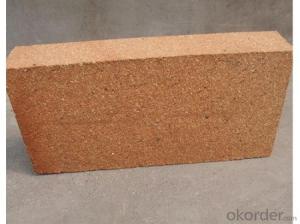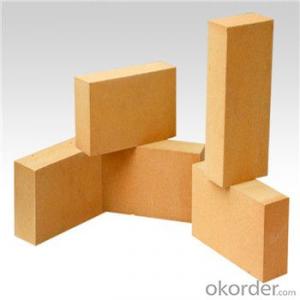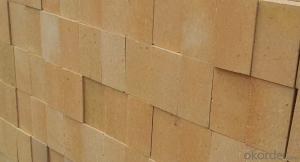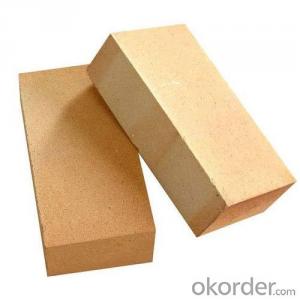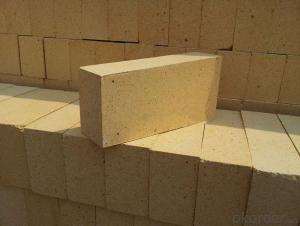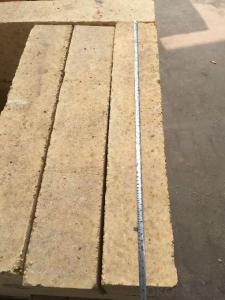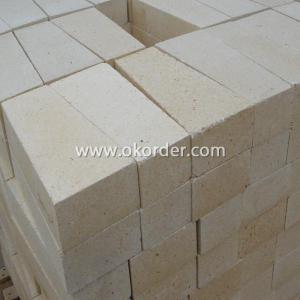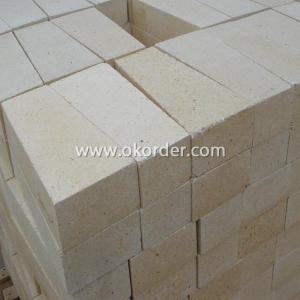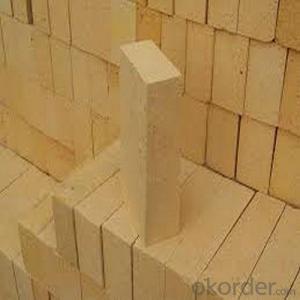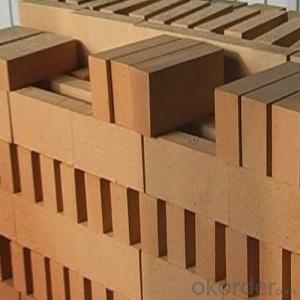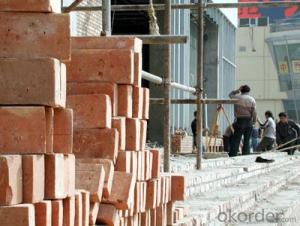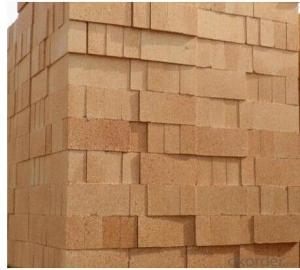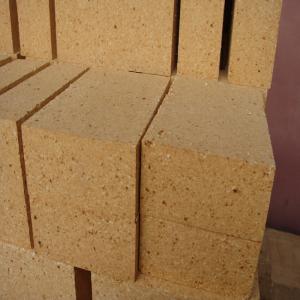Fireclay Brick with Al2O3 Content around 38%
- Loading Port:
- Qingdao
- Payment Terms:
- TT or LC
- Min Order Qty:
- 17 m.t
- Supply Capability:
- 10000 m.t/month
OKorder Service Pledge
OKorder Financial Service
You Might Also Like
General Information
CMAX fireclay bricks are made from clinker clay by mixing, forming, drying, sintering and machining. The alumina content ranges from 36% to 48%. Fireclay bricks feature stable mechanical strength and good thermal shock resistance, withstanding high temperature up to 1750°C.
Application
Petrochemical process heater
Heat treatment furnace
Tunnel kiln
Trolley furnace
Ceramic firing kiln
Cement rotary kiln
Glass melting tank
Blast furnace
Hot-blast furnace
Refractory heat face of furnace
Features
◆Low thermal conductivity ◆High refractoriness
◆High mechanical strength ◆Excellent thermal shock resistance
◆High Strength ◆Lower shrinkage,
◆Good Alkalis Resistant ◆Good resistant to Thermal Shock
ITEM | UNF42 | UNF46 | ZGN42 | RN40 | TDL45-12 |
Refractoriness, ℃ | 1730 | 1750 | 1750 | 1730 | 1760 |
Bulk Density, g/cm3 | 2.15 | 2.25 | 2.3 | 2.15 | 2.37 |
Apparent Porosity, % | 22 | 20 | 15 | 24 | 12 |
C.C.S, Mpa | 30 | 35 | 58 | 28 | 68 |
Refractories Under Load (0.2Mpa),℃ | 1400 | 1420 | 1450 | 1430 | 1500 |
Reheating Linear Change, % | 1400℃x2h 0.1~-0.4 | 1430℃x2h 0~-0.1 | 1450℃x2h 0~-0.2 | 1350℃x2h 0~-0.3 | 1450℃x2h -0.1~+0.05 |
Al2O3 Content , % | 42 | 46 | 42 | 40 | 45 |
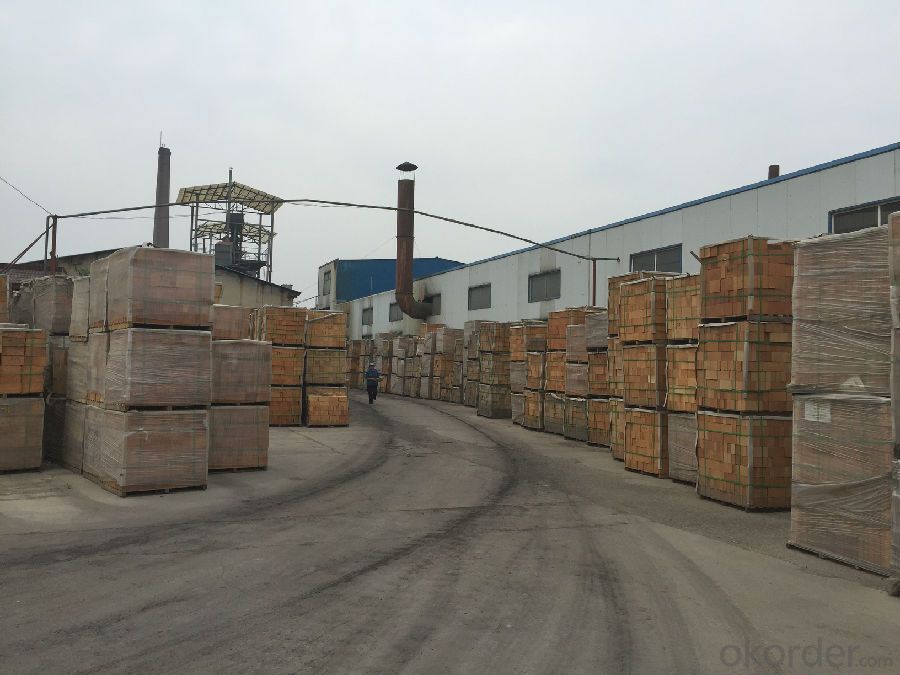
- Q:What are the main constituents in non clay brick sintering?
- Sintered clay brick, it is through the mining soil, brick making, modulation, drying, roasting and cooling produced, roasting coal amount is solid sintered clay brick coal blending amount of 20-60%, the amount of coal to ensure product's surface.
- Q:What are the differences between thermal?insulation?bricks and refractory bricks?
- Thermal insulation brick is thermal insulative; refractory brick is high temperature resistant.
- Q:What are the differences between sintered bricks and refractory bricks?
- Easily weathered. There is no obvious difference in the usage between fired pavingbricks and refractory bricks; sintered bricks are generally used for residential road and landscape engineering, they do not fade; refractory bricks are used for all kinds of kiln constructions in plant: It is not anti-freeze (when the temperature is below the zero degree, the brick will easily "blister" in the saturated state), the reasons are high compressive strength and high temperature zone' heat insulation and so on. Fired pavingbrick is a powerful vacuum extrusion type. Fire suppression road brick is high temperature furnace brick, which is not suitable to be used as road brick. Its characteristics are: Wear resistance and freeze-thaw resistance (the anti freeze-thaw cycle of brick is more than 50 times in saturated state), non weathering, sidewalks, short service life. Sintered brick belongs to the building material, refractory brick belongs to the industrial kiln material, which is easy to moss
- Q:What is the heating temperature in the test method of thermal shock resistance of refractory bricks
- 1, quenching (air cooling or water cooling), after the completion of the specified number of times. 2, maintain 20min, introduce the following types briefly. 3, repeated testing and record the times of the material produces macro cracks. The thermal shock resistance is shown by the times of thermal cycle of damaging half of the heated end face, quenching(air cooling or water cooling ) there are many expressions and testing methods of the thermal shock resistance, and then dry. Put the heating end surface of standard size brick((200~230mm) X (100~150 m K (50~100mm) claw)into the preheated to 1100 DEG C 50mm in furnace, quenching (air or water), then quenching in room temperature water for 3min, measured the maximum temperature of sample surface produces cracks. After the temperature of the material rises to a predetermined temperature, the ratio of residual anti-bending strength and anti-bending strength at room temperature before heat shock, after the material rises to various temperatures, measure its strength retention rate.
- Q:1200 degrees inside the furnace, lay a layer of refractory brick, what is the temperature outside?
- except refractory brick, refractories include refractory concrete (refractory cement+aggregate), fire-resistant insulating layer (refractory cement+vermiculite powder or refractory cement + diatomaceous earth) and so on.
- Q:What material is good of refractory bricks?
- It can also be divided into a variety of kinds, it mainly depends on where it is used, each has its own advantages, neutral three categories of refractory bricks have a variety of materials
- Q:T38 size of high alumina refractory brick
- high alumina brick, according to the aluminum content, is divided into four grades, the aluminum content of the first grade is no less than 75%, also called the special high alumina brick; the aluminum content of the second grade is no less than 65%, the third grade is no less than 55%; the aluminum content of super high aluminium brick is more than 85%; If the shape is very irregular, it is usually called the super special high alumina brick. in short, there is a universal type of high alumina brick except for standard high alumina brick, customised according to the specific appliction of the kiln.
- Q:What refractory mortar is better if masonrying 4 meters height and 114 mm width of refractory brick
- The selection of refractory mud should keep the principle of homogeneous phase with refractory bricks, that is to maintain the same material, according to the suitable temperature, choose appropriate binding agent compensation measuring forging Yao tic surprised boxing super man (phosphate, sodium silicate, or other organic combination), composite high performance admixture, it can be combined better in high temperature.
- Q:does all the refractory refer to refractory bricks when making steel?
- chamotte, castable refractory, etc are shapeless refractory, above are all ferrous metallurgy auxiliary
- Q:How about clay bricks?
- The strength of brick can be judged by the sound produced by two bricks colliding with each other.Two hands each take a brick, gently hit, such as a uniform, crisp sound, indicating brick high strength, good quality, if the collision sound hoarse or stuffy, it shows that brick strength is low.2. to observe the crack state of bricks, elliptical repeat crack if large surface of the brick on the head, like twistcore, called "spiral brick"; some bricks will be broken, the shell off angle, crack and other symptoms, hand picked up the pieces of a pinch, immediately in powder form. The inner core is yellow and honeycombed. It is called "crisp brick", which belongs to the waste brick.3. to observe the color of brick brick brick section: open, heart was uniform black, no unburned carbon brick, high strength of such. On the contrary, the intensity is low.
1. Manufacturer Overview |
|
|---|---|
| Location | |
| Year Established | |
| Annual Output Value | |
| Main Markets | |
| Company Certifications | |
2. Manufacturer Certificates |
|
|---|---|
| a) Certification Name | |
| Range | |
| Reference | |
| Validity Period | |
3. Manufacturer Capability |
|
|---|---|
| a)Trade Capacity | |
| Nearest Port | |
| Export Percentage | |
| No.of Employees in Trade Department | |
| Language Spoken: | |
| b)Factory Information | |
| Factory Size: | |
| No. of Production Lines | |
| Contract Manufacturing | |
| Product Price Range | |
Send your message to us
Fireclay Brick with Al2O3 Content around 38%
- Loading Port:
- Qingdao
- Payment Terms:
- TT or LC
- Min Order Qty:
- 17 m.t
- Supply Capability:
- 10000 m.t/month
OKorder Service Pledge
OKorder Financial Service
Similar products
New products
Hot products
Related keywords
